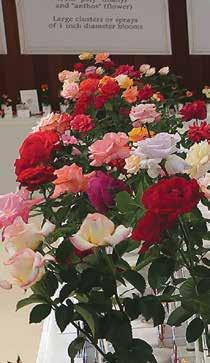Daylily Dynamos others (including the old favorites ‘Stella de Oro’, and ‘Happy Returns’) rebloom freely throughout the summer. Many of the reblooming types will bloom in cycles, meaning that they will bloom for a few weeks, then take a break and start back up again for a few more weeks. Some gardeners may be attracted to the double blooms of ‘Double
‘Stella de Oro’ Pardon Me’ and ‘Siloam Peony Display’, both great for areas that need a little extra impact. Others prefer the ruffled edges of ‘Always Afternoon’, ‘Lavender Blue Baby’ and ‘Blackthorne’. For those gardeners in search of a white flower that doesn’t fade, ‘Sunday Gloves’ is the perfect choice. Each has its value in the landscape. As a clump-forming perennial, the daylily has versatility in the landscape. Shorter varieties lend themselves to be planted along walkways and fronts of borders, and some of the taller types are great as a specimen tucked here and there into a larger landscape or in small masses. As their original, albeit demeaning, nickname sug-
SEAN HOLLAND Perennials Manager 16
June 2022 | kcgmag.com
gests, they do well when grown in ditches and embankments as a form of erosion control. Personally, I find the strength of the daylily in the landscape is in a mixed bed. Though I usually warn against using too many different varieties and plants in a given area of the landscape (it tends to get too busy and wild looking), daylilies seem to be the exception to that All photos courtesy of Walters Gardens.
A
s I sit on my patio with my morning coffee and toast, pondering this article, my eye wanders to the future site of my daylily bed. In my yard, this will be the back of the yard, in full sun, and in that spot where I can’t seem to get anything else to grow—in other words, the perfect place for daylilies. Growers have come a long way from the invasive orange ditch lily native to parts of Asia. With a variety of colors and bloom types, daylilies are the perfect plant for novices and experienced growers alike; the plethora of varieties lends them to be sought out by collectors as well. Though each bloom only lasts for a day and there are thousands of registered cultivars, most varieties on the market for gardeners today retain the best attributes of the original. Daylilies (genus Hemerocallis) are possibly the easiest sun perennial to grow, especially in tough areas of the landscape. They tolerate a wide range of soil types, including heavy clay, and are drought tolerant once established. Some gardeners have success planting them in part sun, or even shadier spaces, but they will be healthiest where they receive over 6 hours of direct sun each day. Also, be mindful that even though they will survive a drought and still bloom, daylilies give their best show when receiving about an inch of water per week. When surveying the different varieties available, it is hard to imagine that hybridizers were able to unlock such a color palette from the genetics of just a few varieties of yellow, orange, and red. Some varieties, classified as standard daylilies bloom for a few weeks with spectacular flowers (‘Primal Scream’, ‘Ruby Spider’, ‘Bela Lugosi’ and ‘Mighty Chestnut’) while
rule. Nothing tops the unique appearance of a standard daylily in bloom, but a garden with standard daylilies only has color for a short time. I recommend selecting your favorite standard daylilies, then mixing in a variety of reblooming types to add season-long color even when the standard types give their final bow for the season. Daylily gardens are great areas to plant a few spring bulbs; as the bulbs fade, the daylilies will grow in and cover the dying bulb foliage. For the same reason as mixing standard and reblooming cultivars in a bed, I also like to recommend planting a few Asiatic and Oriental lilies as well; just be sure to give the Asiatic lilies a little extra space
as they can multiply. When selecting daylilies at your local garden center, look for plants that have multiple “fans” in the pot, if possible. This indicates that the plant is already beginning to multiply and will mature in the landscape faster. Daylilies are fast growers, so don’t stress if you can only find single-fans, especially in the springtime when the garden centers are bringing in young plants. Most perennials, including daylilies, do not like to be in their grower’s pot, and may drop an occasional leaf. If there is a brown or yellow leaf, this isn’t an indication that the plant is sick; simply remove them at the time of planting. Plant daylilies in areas that receive at least 6 hours of sunlight per day. They tolerate a wide range of soil types, but will quickly die in soggy/wet soils. If they are going in an area that stays wet for many days after a rain, amend the area with compost when planting. Fertilizer is generally not necessary for daylily success, but an application of slow-release balanced or bloomboosting fertilizer in springtime can give them a boost and encourage a better show in the summer. Pests and diseases are rarely a problem; the most common issue is daylily rust. Rust is a foliar fungus that frequently occurs during the humid summer, especially if the garden is frequently watered by a lawn sprinkler system (the least favorable watering option). If your lilies begin to show signs of rust on the foliage, copper fungicide can be used to help mitigate the problem. Never compost foliage from any plant that exhibits a disease problem. For more information on daylilies, or if you are a daylily enthusiast and would like to join fellow daylily fans, I encourage you to check out local and national organizations.
Sean Holland is Perennials Manager at Suburban Lawn & Garden, 135th and Wornall location, in Kansas City, Missouri. You may reach him at seanh@suburbanlg.com.













